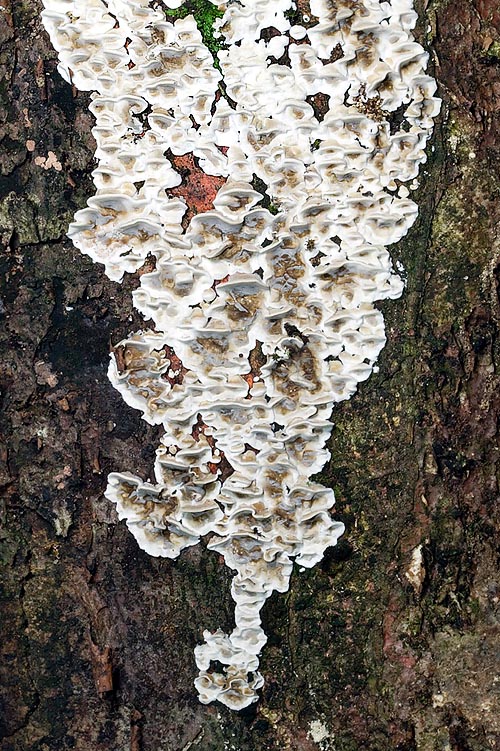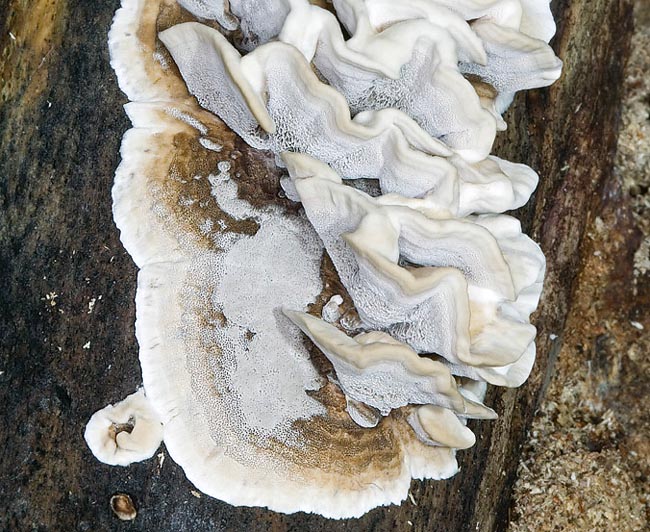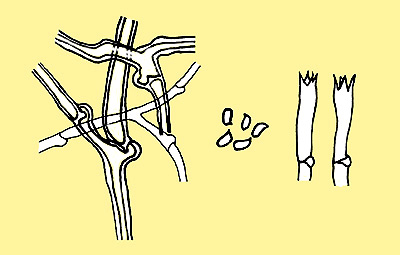
Text © Massimiliano Berretta

English translation by Mario Beltramini

Bjerkandera adusta grows on trunks, better if dead © Giuseppe Mazza
Family: Meruliaceae Rea, 1922.
Genus: Bjerkandera Karsten, 1879.
Bjerkandera adusta (Willdenow: Fries) Karsten, 1879.
The term “adusta” comes the Latin “ustus” = burnt, scorched, due to the typical colour of the hymenium. In Italy and in Spain there are no common names for this species; in France, on the contrary, it is known as “Tramète brûlée”, “Polypore brulé”; in Germany “Angebrannter Rauchporling”, in the UK “Smoky Bracket”.
Description of the genus
To this genus belong annual basidiomes, bracketed, often imbricate of laterally fused, with coriaceous-elastic consistency; the sterile surface is finely tomentose and zonate at times; the hymenium is porous, grey or brown with small and roundish pores, the tubules are concolorous; the context is ochraceous, separated by a black line from the layer of the tubules. The hyphal system is monomitic (structure formed by only generative hyphae, without hyphae of other type), hyphae with clamp connections; hyaline basidiospores, white spore print, non amyloid, smooth, from ellipsoidal to sub-cylindrical. They are saprophytic or week parasites of latifoliate trees (rarely conifers), causing a white rot. The species typus is Bjerkandera adusta.
Description of the species
Cap: annual basidiomes, bracketed, imbricate and fused laterally, at times they can cover wide areas on the trunks, the single fruitbody goes from 3 to 7 cm, the pileus surface, when present, is finely velvety, with brown concentric zonations with wavy margins, initially whitish, especially in the resupinate forms, then dark grey.
Hymenium: porous, from grey to blackish, with 4-6 pores per mm, roundish, stretched and irregular in the more vertically grown forms; 1-2 mm thick tubules, smoke grey, separated from the context by a thin black line.
Stipe: absent.
Flesh: the trama is thin, with a thickness going from few millimetres up to a maximum of 10 mm, of coriaceous-elastic consistency, the colour goes from the whitish to the pale ochre.

Significant close-up. Intense and good smell, but it is not edible © Giuseppe Mazza
Smell: very intense and pleasant in the fresh specimens, disappears when dried.
Habitat: it grows all over the year on stumps and dead trunks of broad-leaved trees, less frequent on living plants, rarely on conifers.
Edibility: of no value.
Microscopy: monomitic hyphal structure with generative hyphae provided of clamp connections and ramified, with thin walls, with diameter of 2-4 µm in the sub-hymenium.
In the trama the walls are thickened or solid with a diameter up to 7 µm with irregular pattern.
The pileus hyphae are united in cords reaching a length of more than 100 µm.
Ellipsoidal basidiospores, smooth, hyaline, non amyloid, 4-6 × 2,3-3,5 µm.
Clavate basidia, with clamp connections at the base, 10-18 × 3,5-6 µm.
Remarks: it is a fairly diffused species in Europe, in North America and also in Asia, in the woods as well as in the parks or in the gardens, on dead wood of broadleaf, more rarely on needle leaved trees, and is origin of white rot of the wood.
It is a rather slow-growing parasitic fungus, once installed in the plant it causes its death and continues in developing on it as saprotroph.

Bjerkandera adusta generative hyphae, spores and basidia © Angeli
It can be mistaken with Bjerkandera fumosa (Persoon: Fries) Karsten 1879, which, however, is quite less diffused, at least in Italy, it differs due to the darker colouration of the carpophore, the spores slightly smaller, the porous surface from whitish to cream and the pores slightly bigger, the habitat is only on broad-leaved plants.
Synonyms
Boletus adustus Willdenow 1787 (basionym); Gloeoporus adustus (Willdenow) Pilát 1937; Grifola adusta (Willdenow) Zmitrovich & Malysheva 2006; Leptoporus adustus (Willdenow) Quélet 1886; Polyporus adustus (Willdenow) Fries 1821; Polystictus adustus (Willdenow) Fries; Polystictus adustus (Willdenow) Gillot & Lucand 1890; Tyromyces adustus (Willdenow) Pouzar 1966.
→ For general notions about Fungi please click here.
→ To appreciate the biodiversity of MUSHROOMS please click here.
